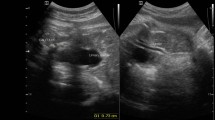Abstract
Three cases of intracolonic lithiasis are described, one in a fetus aborted at 19 weeks' gestation and two in premature infants delivered at 31 and at 32 weeks' gestation, respectively. The first infant died on the 2nd day of life while the other is currently doing well. The common features in all three were: radio-opaque intraluminal stones, imperforate anus with a fistula between the distal colon and the urinary tract, urinary outflow obstruction, and oligohydramnios. We postulate that the colonic calculi (commonly assumed to be intraluminal calcification) developed as a result of prenatal admixture of meconium and urine with distal urinary tract obstruction. It is important to distinguish this clinical entity from meconium peritonitis, which gives similar radiographic findings.
Similar content being viewed by others
References
Beasley SW, de Campo M (1986) Intraluminal calcification in the newborn: diagnostic and surgical implications. Pediatr Surg Int 1: 249–251
Berdon WE, Baker DH, Wigger HJ, Mitsudo SM, Williams H, Kaufmann HJ (1975) Calcified intraluminal meconium in males with imperforate anus. AJR Am J Roentgenol 125: 449–455
Camp R, Roberts MH (1949) Multiple calcareous deposits in the intestinal tract of the newborn. Am J Dis Child 78: 393–400
Daneman A, Martin DJ (1979) A syndrome of multiple gastrointestinal atresias with intraluminal calcification. Pediatr Radiol 8: 227–231
Felman AH, Walker RD, Donnelly WH, Gerami S (1975) Supralevator imperforate anus with unusual associated anomalies: colonic ureteral ectopy, intraluminal calcified meconium. Pediatr Radiol 3: 78–80
Fletcher BD, Yulish BS (1978) Intraluminal calcifications in the small bowel of newborn infants with total colonic aganglionosis. Pediatr Radiol 126: 451–455
Herring LC (1962) Observations on the analysis of ten thousand urinary calculi. J Urol 88: 545–562
Neuhauser EBD (1944) The roentgen diagnosis of fetal meconium peritonitis. AJR Am J Roentgenol 51: 421–425
Pouillaude JM, Meyer P, Minh VT, Valla JS (1987) Enterolithiasis in two neonates with oesophageal and anorectal atresia. Pediatr Radiol 17: 419–421
Yousefzadeh DK, Jackson Jr JH, Smith WL, Lu ChH (1984) Intraluminal meconium calcification without distal obstruction. Pediatr Radiol 14: 23–27
Author information
Authors and Affiliations
Additional information
Correspondence to: J. M. Hutson
Rights and permissions
About this article
Cite this article
Goh, D.W., Middlesworth, W., Stephens, F.D. et al. Intracolonic lithiasis —a result of prenatal admixture of urine and meconium?. Pediatr Surg Int 8, 222–225 (1993). https://doi.org/10.1007/BF00182523
Accepted:
Issue Date:
DOI: https://doi.org/10.1007/BF00182523




